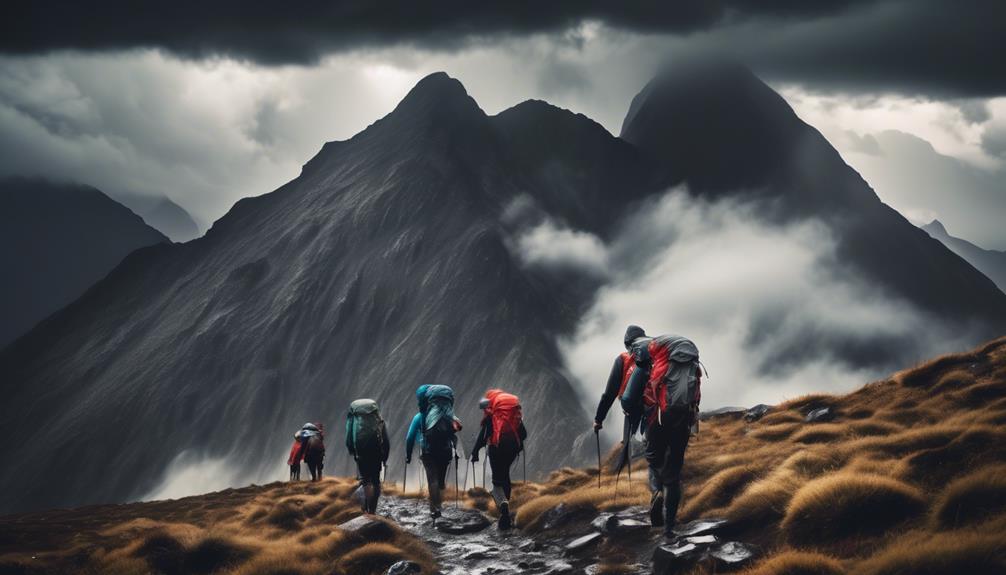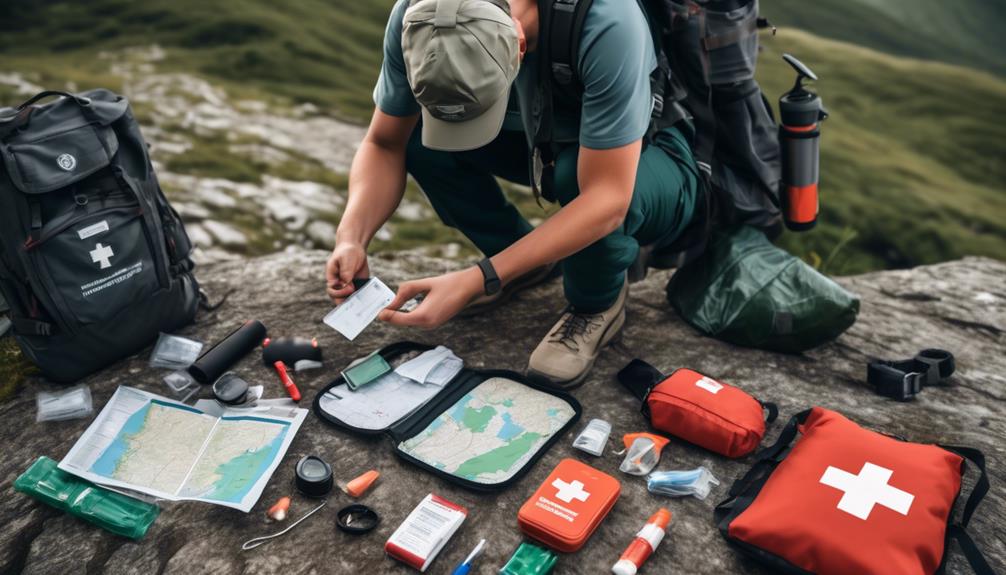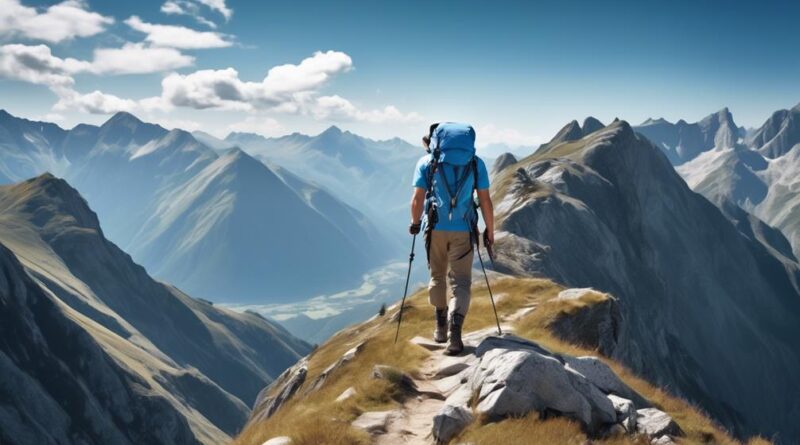How-to Guide: Preparing and Ensuring Safety in Mountain Trekking
Before you embark on the exhilarating journey of mountain trekking, it's crucial to ensure that you're well-prepared for the challenges that lie ahead.
The path to conquering the peaks is not just about reaching the summit, but also about the meticulous planning and precautions that pave the way.
From essential gear and physical training to understanding the elements and wildlife encounters, each aspect plays a pivotal role in your safety and success.
As you set foot on this adventure, you'll discover the key strategies that will be your compass through the rugged terrain, ensuring that you're equipped to face the unknown with confidence and resilience.
Essential Gear and Equipment
Before embarking on a mountain trek, ensure that you have the essential gear and equipment necessary for a safe and successful journey. Gear selection is crucial for your comfort and safety. Choose appropriate clothing, including moisture-wicking base layers, insulating layers, and a waterproof and windproof outer layer. Your footwear should provide ankle support and have a good tread for traction. Additionally, select a backpack that fits well and is suitable for carrying the necessary supplies. It's also important to have a reliable map, compass, and GPS device to aid navigation.
Equipment maintenance is equally important. Inspect all gear before your trek to ensure it's in good condition. Check your backpack for any damages, and make sure that zippers, buckles, and straps are functioning properly. Inspect your clothing for any tears, and ensure that your waterproof outer layer is still effective. Examine your footwear for any signs of wear and tear, and replace any worn-out or damaged gear before your trek.
Taking the time to carefully select your gear and maintain your equipment won't only enhance your comfort during the trek but also contribute to your safety. By being well-prepared and having reliable gear, you can focus on enjoying the stunning views and the exhilaration of conquering the mountain.
Physical Fitness and Training
To ensure a safe and enjoyable mountain trekking experience, it's essential to prioritize your physical fitness and training. Injury prevention should be a top priority when preparing for mountain trekking. Engaging in regular strength and flexibility training can help reduce the risk of common trekking injuries such as sprains, strains, and muscle fatigue.
Include exercises that target the core, legs, and ankles to improve stability and balance, which are crucial for navigating uneven and rocky terrain. Additionally, focusing on endurance building is vital for tackling long and strenuous treks. Incorporate activities such as hiking, running, cycling, and swimming into your fitness routine to enhance cardiovascular endurance and stamina. Gradually increase the intensity and duration of your workouts to simulate the physical demands of mountain trekking.
It's also important to gradually acclimate yourself to higher altitudes if your trek involves elevation gain. This can help prevent altitude sickness and ensure a safer and more enjoyable experience. Incorporate high-intensity interval training (HIIT) sessions to simulate the varying intensity levels encountered during mountain trekking. Remember to listen to your body and rest when needed to avoid overtraining and potential injuries.
Understanding Weather Conditions

Understanding weather conditions is crucial for ensuring a safe and successful mountain trekking experience. Weather forecasting plays a vital role in preparing for your trek, as it helps you anticipate and plan for potential weather-related challenges.
Here are three important reasons why understanding weather conditions is essential for your mountain trekking adventure:
- Safety: Sudden changes in weather, such as unexpected storms or extreme temperature fluctuations, can pose significant risks to trekkers. By staying informed about the weather forecast, you can make informed decisions about when to start, continue, or abort your trek, keeping yourself and your group safe from potential weather-related hazards.
- Altitude Sickness Prevention: Weather conditions, such as low oxygen levels and rapid changes in atmospheric pressure, can exacerbate the risk of altitude sickness. By understanding the weather patterns specific to the altitude of your trekking route, you can take necessary precautions to prevent altitude sickness and ensure a smoother acclimatization process.
- Route Planning: Weather conditions greatly influence the feasibility and safety of specific trekking routes. Understanding the typical weather patterns and potential deviations from the norm enables you to select the most suitable routes for your trek, minimizing the risk of encountering impassable or hazardous terrain due to weather-related factors.
Navigation and Route Planning
Considering the diverse terrain and potential challenges, careful navigation and route planning are crucial for ensuring a safe and successful mountain trekking experience. When preparing for a mountain trek, map reading and GPS technology are invaluable tools for navigation. Familiarize yourself with topographic maps of the area and identify key landmarks, such as peaks, valleys, and rivers, to aid in route planning. GPS devices can provide real-time location tracking, helping you stay on course even in challenging conditions.
Trail selection is another vital aspect of route planning. Evaluate the difficulty and distance of potential trails, considering your group's skill level and physical condition. Additionally, analyze the terrain along the chosen route to anticipate any obstacles or hazards. Understanding the elevation gain, trail conditions, and potential water crossings will help you prepare adequately and navigate safely during the trek.
Before setting out, share your planned route with someone responsible who can raise the alarm if you don't return as scheduled. This simple precaution can be a lifesaver in case of unforeseen circumstances. Moreover, always carry a paper map and compass as a backup to electronic devices, as batteries can fail, and GPS signals may be unreliable in certain areas.
Safety Protocols and Emergency Procedures

As you trek through the mountains, ensuring your safety and preparedness for emergencies is paramount, building upon your navigation and route planning to equip yourself with the necessary protocols and procedures.
It's crucial to have a solid understanding of emergency response and risk assessment to handle unexpected situations. Here are some essential safety protocols and emergency procedures to keep in mind:
- Risk Assessment: Before embarking on any trek, take the time to assess the potential risks associated with the terrain, weather conditions, and the difficulty of the trail. Understanding the risks will help you prepare for potential emergencies and make informed decisions along the way.
- Emergency Communication: Always carry a fully charged mobile phone or a satellite communication device. In case of an emergency, being able to communicate with emergency services or your support team can make a significant difference in the outcome of the situation.
- First Aid Training: Equip yourself with basic first aid knowledge and a well-stocked first aid kit. Being able to provide immediate medical assistance in the event of an injury can be life-saving.
Hydration and Nutrition Strategies
To maintain your energy levels and prevent dehydration while trekking in the mountains, it's essential to prioritize hydration and nutrition.
Hydration tips are crucial for ensuring your body can cope with the physical demands of mountain trekking. Start by carrying an adequate supply of water and a hydration pack to sip on while walking. It's recommended to drink at least 1 liter of water every 2 hours, but adjust this based on your activity level, weather conditions, and individual needs. Additionally, consider using electrolyte tablets to replenish essential minerals lost through sweat. These tablets can be added to your water to help maintain proper hydration levels.
Nutritional snacks play a vital role in sustaining your energy levels during a mountain trek. Pack lightweight, high-energy snacks such as nuts, trail mix, energy bars, and dried fruits. These snacks provide a quick source of energy and essential nutrients. It's important to consume small, frequent snacks throughout the trek to keep your energy levels steady. Also, consider bringing along foods high in complex carbohydrates and protein, such as whole grain crackers with cheese or nut butter, to provide sustained energy.
Wildlife Awareness and Encounters

Maintaining your energy levels and staying hydrated while trekking in the mountains is crucial, and it's equally important to be aware of wildlife and how to handle potential encounters. When venturing into the wilderness, being prepared for wildlife encounters is essential for your safety and the well-being of the animals. Here are some key points to keep in mind:
- Animal Behavior: Understanding the behavior of wildlife is crucial. Respect their space and avoid getting too close. Animals may perceive humans as a threat, especially if they feel cornered or surprised. Stay alert and watch for signs of agitation or distress in the animals you encounter.
- Wilderness Safety: When trekking in the mountains, always make noise to alert animals of your presence. This helps prevent surprising them and potentially triggering defensive behavior. Additionally, avoid leaving food or waste behind, as it can attract wildlife to camping areas and hiking trails, leading to potentially dangerous encounters.
- Emergency Protocols: Despite all precautions, wildlife encounters can still occur. In the event of an encounter, remain calm and slowly back away, giving the animal an escape route. Always carry bear spray or other wildlife deterrents and know how to use them effectively in case of an emergency.
Leave No Trace Principles
Applying the Leave No Trace Principles is essential for minimizing your impact on the environment while trekking in the mountains. Campsite etiquette plays a crucial role in preserving the natural beauty of the mountains. When setting up camp, choose a durable surface such as rock, gravel, or snow to pitch your tent. This minimizes the impact on vegetation and soil. Remember to pack out all waste, including food scraps and biodegradable items. Leaving behind organic waste can disrupt the natural balance of the ecosystem and attract wildlife to the campsite, leading to potential conflicts.
Environmental preservation is at the core of Leave No Trace Principles. It's important to respect wildlife and their habitats by keeping a safe distance and not leaving any food or scraps that could alter their natural behavior. Avoid cutting branches or damaging vegetation, as these plants play a vital role in the ecosystem. When creating a fire pit, use existing fire rings whenever possible to reduce the impact on the landscape. Make sure to fully extinguish the fire and dismantle the pit before leaving the campsite.
Frequently Asked Questions
Are There Any Specific Cultural or Historical Considerations to Keep in Mind When Trekking in Certain Mountain Regions?
When trekking in certain mountain regions, it's important to be mindful of cultural etiquette and historical landmarks. Respect local customs, dress modestly, and be aware of sacred sites. Engaging with locals can offer valuable insights into the area's rich history and traditions.
What Are Some Common Mental Challenges That Trekkers May Face During Mountain Expeditions, and How Can They Be Overcome?
When trekking mountains, you may face mental challenges like fear and doubt. Overcome by building mental resilience through mindset strategies. Seek emotional support from your group and focus on small, achievable goals to boost confidence.
How Can Trekkers Minimize Their Environmental Impact When Using Camping and Cooking Gear in Mountainous Areas?
To minimize waste and adhere to leave no trace principles in mountainous areas, you should pack reusable camping and cooking gear, properly dispose of any waste, and avoid using single-use items. Leave the environment as you found it.
What Are Some Lesser-Known First Aid Techniques or Remedies That Can Be Useful in Mountain Trekking Emergencies?
In mountain trekking emergencies, improvising first aid with natural remedies can be crucial. You might use items like honey for wound care, willow bark for pain relief, and activated charcoal for toxin absorption. Always seek professional medical help when available.
Are There Any Unique Safety Considerations for Trekking at High Altitudes That Are Not Covered in the Article?
When trekking at high altitudes, unique challenges like acclimatization and altitude sickness require special attention. Ensure thorough emergency response preparation and prioritize mountain trekking safety with knowledge of these factors.
Conclusion
Now that you have all the essential information on preparing for a mountain trek, it's time to put it into action.
Remember to pack the right gear, stay physically fit, and be aware of the weather and wildlife.
Always follow safety protocols and leave no trace behind.
With proper preparation and caution, you can enjoy a safe and unforgettable mountain trekking experience.
Happy trails!
